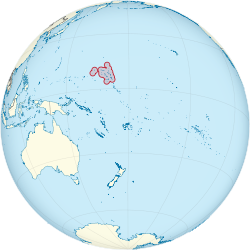Republic of the Marshall Islands
|
Republic of the Marshall Islands Aolepān Aorōkin M̧ajeļ
|
|||||
|---|---|---|---|---|---|
|
|||||
|
Motto: "Jepilpilin ke ejukaan"
"Accomplishment through joint effort" |
|||||
 |
|||||
| Status | US Associated State | ||||
| Capital and largest city |
Majuro 7°7′N 171°4′E / 7.117°N 171.067°E |
||||
| Official languages | |||||
| Ethnic groups (2006) |
|
||||
| Demonym | Marshallese | ||||
| Government | Unitary parliamentary republic | ||||
| Hilda Heine | |||||
| Kenneth Kedi | |||||
| Legislature | Nitijela | ||||
| Independence | |||||
|
• Self-government
|
1979 | ||||
| October 21, 1986 | |||||
| Area | |||||
|
• Total
|
181.43 km2 (70.05 sq mi) (213th) | ||||
|
• Water (%)
|
n/a (negligible) | ||||
| Population | |||||
|
• 2016 estimate
|
53,376 (203rd) | ||||
|
• 2011 census
|
53,158 | ||||
|
• Density
|
293.0/km2 (758.9/sq mi) (28th) | ||||
| GDP (PPP) | 2001 estimate | ||||
|
• Total
|
$115 million (220th) | ||||
|
• Per capita
|
$2,900a (195th) | ||||
| Currency | United States dollar (USD) | ||||
| Time zone | MHT (UTC+12) | ||||
| Date format | MM/DD/YYYY | ||||
| Drives on the | right | ||||
| Calling code | +692 | ||||
| ISO 3166 code | MH | ||||
| Internet TLD | .mh | ||||
|
|||||
Coordinates: 9°N 168°E / 9°N 168°E
The Marshall Islands, officially the Republic of the Marshall Islands (Marshallese: Aolepān Aorōkin M̧ajeļ), is an island country located near the equator in the Pacific Ocean, slightly west of the International Date Line. Geographically, the country is part of the larger island group of Micronesia. The country's population of 53,158 people (at the 2011 Census) is spread out over 29 coral atolls, comprising 1,156 individual islands and islets. The islands share maritime boundaries with the Federated States of Micronesia to the west, Wake Island to the north,Kiribati to the south-east, and Nauru to the south. About 27,797 of the islanders (at the 2011 Census) live on Majuro, which contains the capital.
Micronesian colonists gradually settled the Marshall Islands during the 2nd millennium BC, with inter-island navigation made possible using traditional stick charts. Islands in the archipelago were first explored by Europeans in the 1520s, with Spanish explorer Alonso de Salazar sighting an atoll in August 1526. Other expeditions by Spanish and English ships followed. The islands derive their name from British explorer John Marshall, who visited in 1788. The islands were historically known by the inhabitants as "jolet jen Anij" (Gifts from God).
...
Wikipedia


